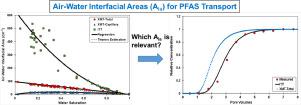Water Research ( IF 11.4 ) Pub Date : 2021-10-21 , DOI: 10.1016/j.watres.2021.117785 Mark L Brusseau 1 , Bo Guo 2

|
Per and polyfluoroalkyl substances (PFAS) present in the soil pose a long-term threat to groundwater. Robust characterization and modeling of PFAS retention and transport in unsaturated systems requires an accurate determination of the magnitude of air-water interfacial area (AWIA). Multiple methods are available for measuring or estimating air-water interfacial area, including x-ray microtomography (XMT), various aqueous and gas-phase interfacial tracer-test (ITT) methods, and thermodynamic-based estimation methods. AWIAs determined with the different methods can vary significantly. Therefore, it is critical to determine which measurement methods are relevant for application to PFAS retention and transport. This is achieved by employing AWIAs determined with different methods to simulate the results of miscible-displacement experiments reported in the literature for the transport of perfluorooctanoic acid (PFOA) in an unsaturated quartz sand. Measured PFOA breakthrough curves were successfully predicted using AWIA values measured by aqueous ITT methods. Conversely, AWIAs measured with the XMT method and estimated with the thermodynamic method under-predicted the magnitude of retardation and could not successfully simulate the measured transport data. These results indicate that the ITT method appears to provide the most appropriate AWIA values for robust characterization and modeling of PFAS transport in unsaturated systems. The long-term impact of employing different AWIA values on PFOA leaching in the vadose zone was simulated for a representative AFFF application scenario. The predicted timeframes for PFOA migration to groundwater varied from 3 to 6 to 20 years depending on which AWIA was used in the simulation. These relatively large differences would result in significantly different risk-assessment outcomes. These results illustrate that it is critical to employ the AWIA that is most representative of PFAS retention for accurate predictions of PFAS leaching in the vadose zone.
中文翻译:

与全氟和多氟烷基物质的运输相关的空气-水界面区域
土壤中存在的全氟和多氟烷基物质 (PFAS) 对地下水构成长期威胁。PFAS 在不饱和系统中的保留和传输的稳健表征和建模需要准确确定空气-水界面面积 (AWIA) 的大小。有多种方法可用于测量或估计空气-水界面面积,包括 X 射线显微断层扫描 (XMT)、各种水相和气相界面示踪剂测试 (ITT) 方法以及基于热力学的估计方法。使用不同方法确定的 AWIA 可能会有很大差异。因此,确定哪些测量方法与 PFAS 保留和运输的应用相关至关重要。这是通过使用用不同方法确定的 AWIA 来模拟文献中报道的不饱和石英砂中全氟辛酸 (PFOA) 传输的混相置换实验结果来实现的。使用通过水性 ITT 方法测量的 AWIA 值成功预测了测量的 PFOA 突破曲线。相反,用 XMT 方法测量并用热力学方法估计的 AWIA 低估了延迟的大小,无法成功模拟测量的传输数据。这些结果表明,ITT 方法似乎提供了最合适的 AWIA 值,用于对不饱和系统中的 PFAS 传输进行稳健的表征和建模。对于具有代表性的 AFFF 应用场景,模拟了采用不同 AWIA 值对渗流区 PFOA 浸出的长期影响。PFOA 迁移到地下水的预测时间范围从 3 年到 6 年到 20 年不等,具体取决于模拟中使用的 AWIA。这些相对较大的差异将导致显着不同的风险评估结果。这些结果表明,使用最能代表 PFAS 保留的 AWIA 对准确预测渗流区 PFAS 浸出至关重要。











































 京公网安备 11010802027423号
京公网安备 11010802027423号